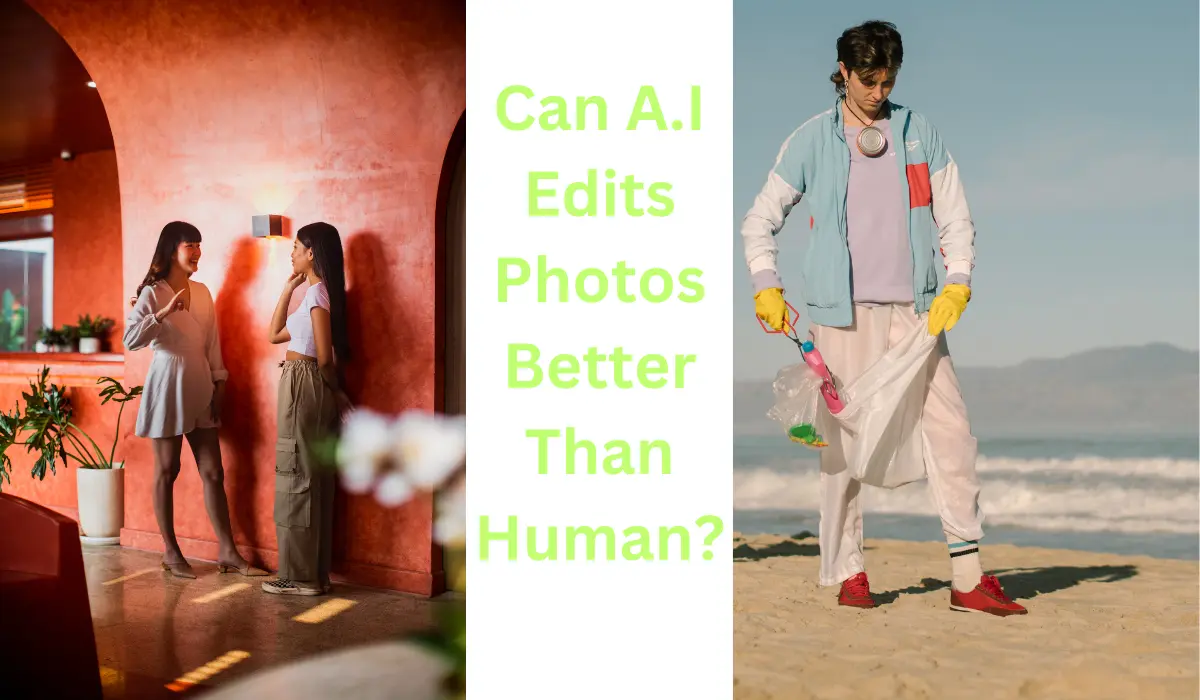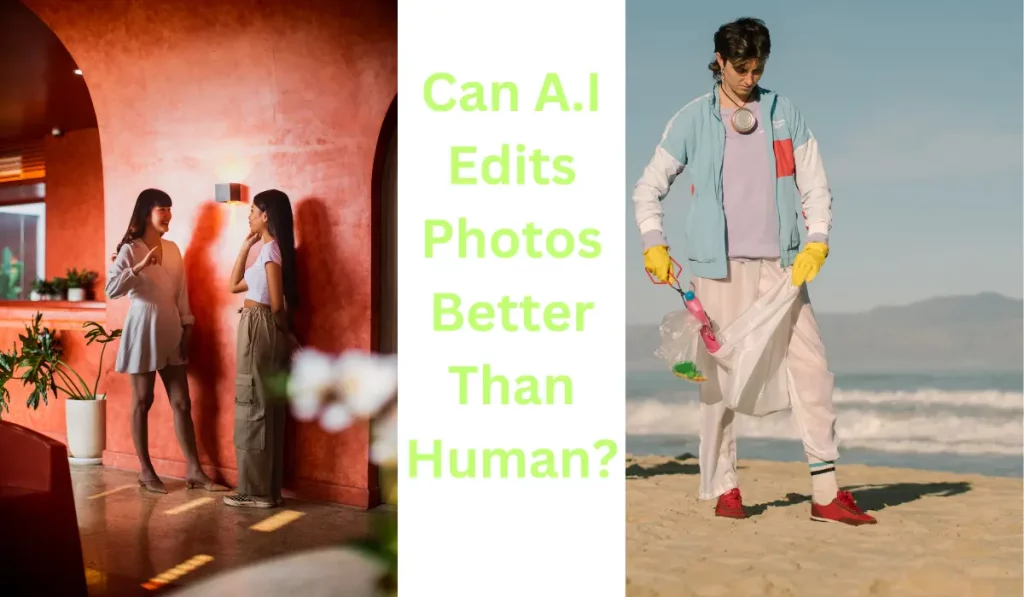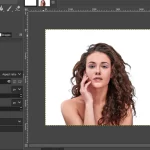All around AI is working and it is said that it will dominate the earth in the near future. Content creation, video making, editing, photo editing, etc. work automation can be done quickly and efficiently. It is a big question whether can AI do the work better than humans. In this context, my focus is on photo edits by AI. Can AI edits photos better than human?
Let’s jump into the deep:
What is A.I
AI, or Artificial Intelligence, refers to the simulation of human intelligence in machines that are programmed to think and learn like humans. It involves creating computer systems or software that can perform tasks that typically require human intelligence. These tasks include:
Learning: AI systems can learn from data and improve their performance over time. This is often done through machine learning techniques, where algorithms are trained on large datasets to recognize patterns and make predictions.
Reasoning: AI systems can use logic and algorithms to solve complex problems, make decisions, and draw conclusions.
Problem Solving: AI can be designed to solve specific problems or perform tasks, such as playing chess, diagnosing medical conditions, or driving a car.
Natural Language Processing: AI can understand, interpret, and generate human language. This is used in chatbots, virtual assistants, and language translation services.
Perception: AI systems can use sensors and data to perceive and interact with their environment. This is crucial in applications like computer vision, where AI can recognize objects in images and videos.
Robotics: AI is often used in conjunction with robots to enable them to perform tasks autonomously, such as manufacturing, exploration, or even household chores.
There are different levels of AI, ranging from narrow or weak AI, which is designed for specific tasks, to general or strong AI, which would have the ability to perform any intellectual task that a human can. Currently, most AI applications are narrow AI, but researchers continue to work on advancing the field to achieve more generalized AI capabilities. AI has a wide range of applications across various industries, including healthcare, finance, transportation, and entertainment, among others.
How Artificial Intelligence Edits Photos?
Artificial Intelligence (AI) can edit photos through a process known as “image processing” or “image enhancement.” AI-based photo editing tools use various techniques to automatically improve or modify images based on predefined objectives. Here’s how AI is typically used in photo editing:
Image Enhancement:
AI can enhance the overall quality of an image by adjusting various parameters like brightness, contrast, sharpness, and color balance. It can analyze the image and make adjustments to improve its visual appeal.
Automatic Retouching:
AI can identify and retouch imperfections in photos, such as blemishes on faces, dust spots, or unwanted objects in the background. This is often done using image segmentation techniques.
Background Removal:
AI can separate the subject of a photo from its background, allowing for easy background replacement or removal. This is useful for creating professional-looking portraits or product images.
Style Transfer:
AI can apply artistic styles to photos, mimicking famous painting styles or other visual effects. This is known as style transfer or neural style transfer and is used for creative purposes.
Image Restoration:
AI can restore old or damaged photos by removing scratches, stains, and other artifacts. It can also upscale low-resolution images to a higher resolution using techniques like super-resolution.
Colorization:
AI can add color to black and white photos by analyzing the image’s content and applying appropriate colors to objects and regions.
Face Editing:
AI-powered photo editors can modify facial features, such as changing expressions, age, or even gender. This is used in various applications, including fun filters in social media apps.
Object Recognition:
AI can recognize objects and elements in photos and perform specific edits or enhancements based on the recognized objects. For example, it can adjust the exposure of a sky or enhance the colors of foliage in a landscape photo.
Content-Aware Fill:
AI algorithms can automatically fill in missing or unwanted areas in a photo with content that matches the surrounding environment. This is particularly useful for removing objects from images.
Noise Reduction:
AI can reduce noise in photos taken in low-light conditions, resulting in cleaner and more detailed images.
These AI-based photo editing techniques are often integrated into consumer photo editing applications, making it easier for individuals to enhance and modify their photos without advanced editing skills. Additionally, AI can be used in professional image editing and retouching to save time and achieve consistent results. It’s important to note that AI-enhanced photo editing tools are continuously evolving, and new capabilities and features are being developed regularly.
Weakness of AI Photo Editing
While AI-powered photo editing has made significant advancements and offers numerous benefits, it also has some weaknesses and limitations:
Over-Editing:
AI algorithms can sometimes overprocess images, resulting in unnatural or exaggerated effects. For example, they may make skin appear too smooth or colors overly saturated, leading to an artificial look.
Lack of Creative Judgment:
AI lacks the creative judgment and context awareness that human editors possess. It may not understand the artistic intent behind a photo, leading to edits that don’t align with the photographer’s vision.
Loss of Originality:
AI-driven filters and styles can make photos appear generic, as they are based on predefined templates or popular trends. This can lead to a loss of the photographer’s unique style and creativity.
Inconsistent Results:
The performance of AI photo editing tools can vary depending on the input image and the quality of the AI model. Some images may benefit significantly from AI enhancements, while others may not see significant improvements or may even deteriorate in quality.
Complex Edits:
AI may struggle with more complex editing tasks that require a deep understanding of image content. For example, it may have difficulty accurately replacing backgrounds in images with intricate details.
Privacy Concerns:
AI-based facial recognition and modification tools raise privacy concerns, as they can be misused to manipulate or generate fake images of individuals without their consent.
Resource Intensive:
High-quality AI photo editing often requires significant computational resources, which can be a limitation for users with less powerful devices or slower internet connections.
Learning Curve:
While AI photo editing tools are designed to be user-friendly, they still have a learning curve. Users may need time to understand how to utilize these tools effectively and achieve the desired results.
Ethical Considerations:
The ease with which AI can manipulate images raises ethical concerns related to photo authenticity and trustworthiness. Misuse of AI-edited images for deception or misinformation is a growing concern.
Dependency on Data Quality:
AI models used in photo editing rely on large datasets for training. If the training data contains biases or inaccuracies, it can lead to undesirable results or reinforce existing biases in image editing.
Limited Artistic Input:
Some photographers and artists prefer to have full control over the editing process to express their unique style and creativity. AI may not always align with their artistic preferences.
It’s important for users to be aware of these weaknesses and exercise judgment when using AI photo editing tools. While AI can be a powerful ally in image enhancement and manipulation, it should be used thoughtfully and in conjunction with human judgment to achieve the best results.
Advantages of Photo Editing by Human
Editing photos by humans offers several advantages, particularly when it comes to achieving precise, artistic, and personalized results. Here are some of the key advantages of human photo editing:
Artistic Control:
Human editors have a deep understanding of visual aesthetics, artistic vision, and creativity. They can apply their artistic judgment to enhance or retouch photos in a way that aligns with the photographer’s or client’s unique style and preferences.
Subject Understanding:
Human editors can interpret the subject matter, context, and emotions in a photo, allowing them to make nuanced adjustments that enhance the storytelling aspect of the image.
Customization:
Human editors can tailor their editing techniques to suit the specific requirements of each image. This level of customization is especially valuable for professional photography, where consistency and a unique style are often desired.
Complex Edits:
For images that require intricate and complex editing, such as advanced compositing, photo manipulation, or retouching, human editors have the expertise and creativity to execute these tasks effectively.
Artistic Retouching:
Human editors excel in retouching tasks that require attention to detail, such as removing imperfections, enhancing facial features, or adjusting lighting and shadows in a subtle and natural manner.
Contextual Awareness:
Human editors can take into account the context and purpose of the photo, ensuring that edits align with the intended message or use of the image.
Adaptability:
Human editors can adapt to specific client requests or industry standards, ensuring that the final product meets professional or brand requirements.
Creative Problem-Solving:
In cases where photos have unique challenges or require creative solutions, human editors can apply their problem-solving skills and experience to achieve the desired outcome.
Quality Assurance:
Human editors can meticulously review and quality-check edited images to ensure they meet the highest standards of quality and professionalism.
Ethical Considerations:
Human editors can make ethical decisions regarding the editing of photos, respecting the privacy and consent of individuals featured in the images and avoiding manipulation for deceptive purposes.
Cultural Sensitivity:
Human editors can consider cultural nuances and sensitivities when editing photos, ensuring that the final result is culturally appropriate and respectful.
Consistency:
In professional photography and branding, maintaining a consistent style and look across a set of images is crucial. Human editors can achieve this consistency by applying their expertise consistently to each image.
While human photo editing offers these advantages, it’s essential to recognize that it may be more time-consuming and labor-intensive compared to AI-based editing. Additionally, the cost of hiring skilled human editors can be higher than using automated tools. The choice between human and AI editing depends on the specific needs of the project, the desired level of customization and creativity, and the available resources.
Which is Better, AI or Human for Professional Photo Edits?
The choice between AI and human editors for professional photo edits depends on several factors, including the specific requirements of the project, available resources, and the desired level of customization and creativity. Both AI and human editors have their strengths and limitations, so it’s essential to consider these factors when making a decision:
AI for Professional Photo Edits:
- Efficiency: AI-powered photo editing tools can process large volumes of images quickly and consistently. This is particularly useful for tasks that require bulk editing, such as e-commerce product photos.
- Cost-Effective: AI editing can be more cost-effective for straightforward and repetitive tasks, as it eliminates the need for manual labor.
- Consistency: AI can ensure a consistent look and style across a set of images, which is important for branding and product photography.
- Speed: AI can provide fast turnaround times, making it suitable for projects with tight deadlines.
Human Editors for Professional Photo Edits:
- Artistic Control: Human editors offer a higher degree of artistic judgment, creativity, and customization. They can tailor edits to match the photographer’s or client’s unique vision and style.
- Complex Edits: For images that require intricate retouching, advanced compositing, or creative manipulation, human editors are better equipped to execute these tasks effectively.
- Quality Assurance: Human editors can meticulously review and quality-check edited images to ensure they meet the highest professional standards.
- Contextual Awareness: Human editors can consider the context and purpose of the photo, ensuring that edits align with the intended message or use of the image.
- Ethical Considerations: Human editors can make ethical decisions regarding the editing of photos, respecting privacy and consent, and avoiding manipulation for deceptive purposes.
- Cultural Sensitivity: For images with cultural nuances, human editors can ensure that the final result is culturally appropriate and respectful.
- Creative Problem-Solving: In cases where photos have unique challenges, human editors can apply their problem-solving skills and experience to achieve the desired outcome.
End Words
The choice between AI and human editors for professional photo edits depends on the nature of the project. For routine, high-volume tasks where consistency and efficiency are paramount, AI may be a suitable choice. However, when artistic creativity, complex editing, quality assurance, and ethical considerations are crucial, human editors are likely to be the preferred option. In some cases, a hybrid approach may also be effective, combining AI for initial processing and human editors for final touches and artistic adjustments. Ultimately, the decision should align with the specific goals and requirements of each project.
Read More Articles





